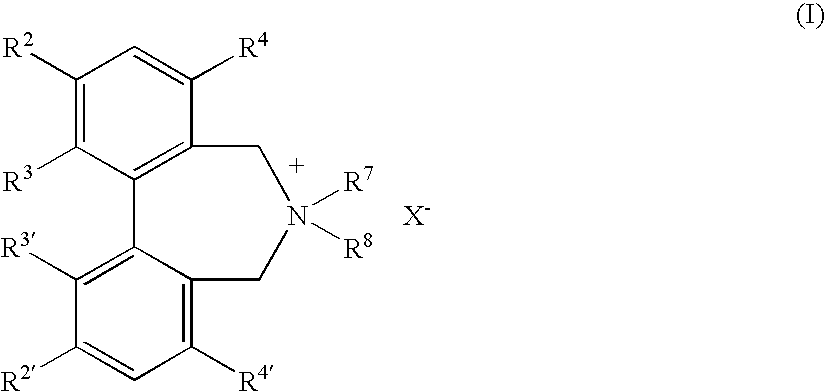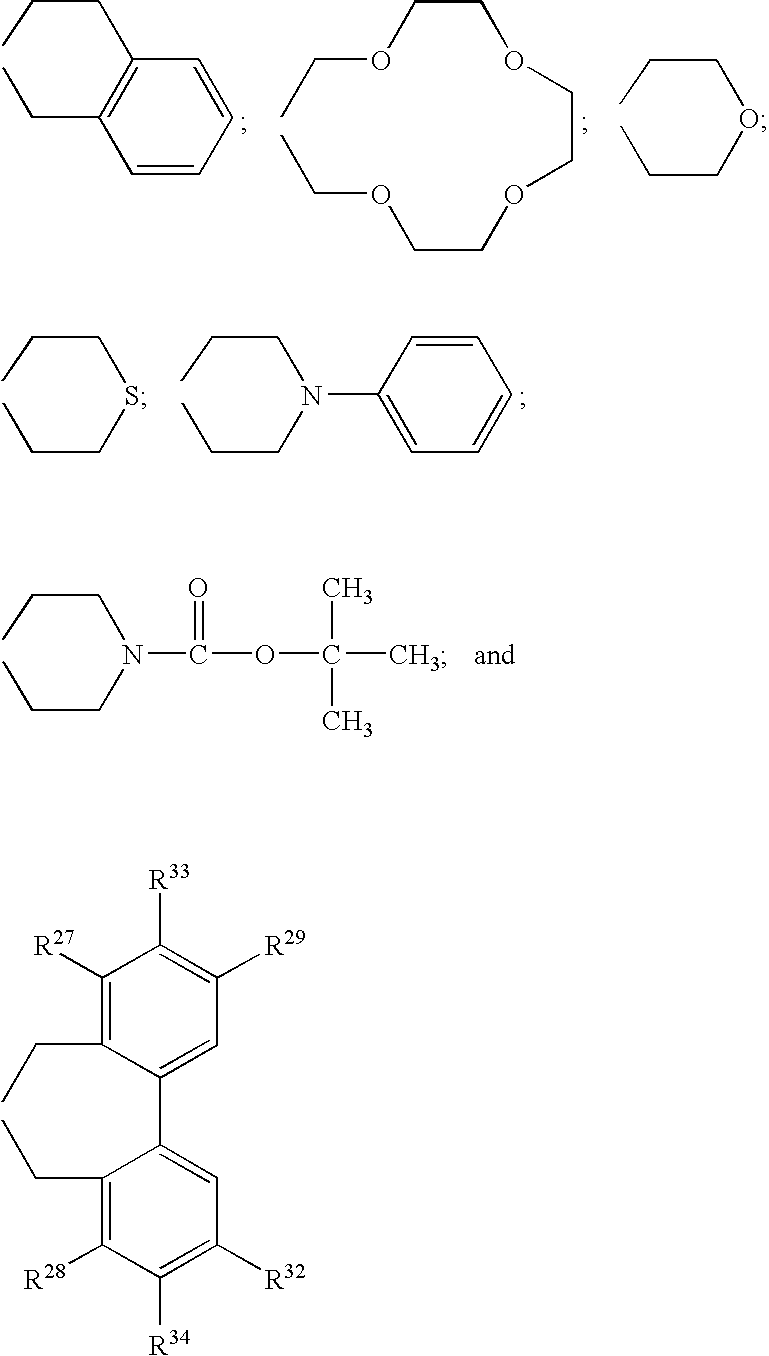Optically active quaternary ammonium salt having axial asymmetry, and method for producing alpha-amino acid and derivative thereof by using the same
a technology of quaternary ammonium salt and axial symmetry, which is applied in the direction of organic compound/hydride/coordination complex catalyst, physical/chemical process catalyst, organic compound/hydride catalyst, etc., can solve the problems of low temperature conditions, slow reaction speed, and lack of practicable methods, and achieves a small number of process steps. , the effect of simple structur
- Summary
- Abstract
- Description
- Claims
- Application Information
AI Technical Summary
Benefits of technology
Problems solved by technology
Method used
Image
Examples
example 1
Synthesis of (S)-2,2′-dimethoxy-6,6′-dimethylbutyl phenyl (6)
[0437]
[0438]Methyl iodide (0.52 mL, 8.3 mmol) and K2CO3 (0.57 mg, 4.2 mmol) were added to a solution of (S)-6,6′-dimethylbiphenyl-2,2′-diol (5) (89 mg, 0.42 mmol) in acetone (5.0 ml). After being stirred at room temperature for 5 hours, the obtained mixture was filtered through a celite pad with ethyl acetate. The filtrate was concentrated to obtain a residue. The residue was purified by silica gel column chromatography (hexane / ethyl acetate) to give the title compound (6) (105 mg, quantitative).
[0439]The physical property data of the obtained compound (6) is shown in Table 1.
TABLE 1Physical property data of compound (6)[α]32D −38 (c 0.60, CHCl3); 1H NMR δ7.21 (t, J = 8 Hz,2H), 6.89 (d, J = 8 Hz, 2H), 6.79 (d, J = 8 Hz, 2H),3.65 (s, 6H), 1.93 (s, 6H); 13C NMR δ156.9,138.1, 127.8, 126.1, 122.1, 108.2, 55.6, 19.5; IR(neat) 2941, 1579, 1466, 1252, 1080, 777, 743 cm−1;HRMS (ESI) Calculated for C16H1902 243.1380 ([M + H+]),Foun...
example 2
Synthesis of (S)-3,3′-dibromo-6,6′-dimethoxy-2,2′-dimethyl-biphenyl (7)
[0440]
[0441]Acetic acid (0.005 mL, 0.083 mmol) and Br2 (0.45 mL, 0.87 mmol) were successively added to a solution of (S)-2,2′-dimethoxy-6,6′-dimethylbiphenyl (6) (105 mg, 0.415 mmol) obtained in Example 1 in CH2Cl2 (4.0 mL). The obtained solution was stirred at room temperature for 1 hour, and poured into an ice-cold saturated NaHCO3 aqueous solution. The organic phase was separated, and the aqueous phase was extracted twice with ethyl acetate. The combined extract was dried over Na2SO4 and concentrated to obtain a residual oil. The oil was purified by silica gel column chromatography (hexane / ethyl acetate) to give the title compound (7) (161 mg, 97%).
[0442]The physical property data of the obtained compound (7) is shown in Table 2.
TABLE 2Physical property data of compound (7)[α]32D −36 (c 0.68, CHCl3); 1H NMR δ7.49 (d, J = 9 Hz,2H), 6.68 (d, J = 8 Hz, 2H), 3.63 (s, 6H), 1.99 (s,6H); 13C NMR δ156.0, 137.3, 131.9,...
example 3
Synthesis of (S)-3,3′-di(3,4,5-trifluorophenyl)-6,6′-dimethoxy-2,2′-dimethylbiphenyl (8)
[0443]
[0444]First, 3,4,5-trifluorophenylboronic acid (868 mg, 5.50 mmol), Pd(OAc)2 (62 mg, 0.28 mmol), P(o-tolyl)3 (P(o-Tol)3: 335 mg, 1.10 mmol), and K3PO4-nH2O (3.93 g, 13.8 mmol) were successively added to a solution of (S)-3,3′-dibromo-6,6′-dimethoxy-2,2′-dimethylbiphenyl (7) (550 mg, 1.37 mmol) obtained in Example 2 in dry DMF (16 mL). After being refluxed under an argon atmosphere overnight, the obtained mixture was filtered through a celite pad with diethyl ether. The filtrate was poured into a mixture of H2O and diethyl ether with vigorous stirring. The organic phase was separated, and the aqueous phase was extracted twice with diethyl ether. The combined extract was dried over Na2SO4 and concentrated to obtain a residue. The residue was purified by silica gel column chromatography (hexane / ethyl acetate) to give the title compound (8) in a quantitative yield.
[0445]The physical property da...
PUM
| Property | Measurement | Unit |
|---|---|---|
| concentration | aaaaa | aaaaa |
| volume ratio | aaaaa | aaaaa |
| optically active | aaaaa | aaaaa |
Abstract
Description
Claims
Application Information
 Login to View More
Login to View More - R&D
- Intellectual Property
- Life Sciences
- Materials
- Tech Scout
- Unparalleled Data Quality
- Higher Quality Content
- 60% Fewer Hallucinations
Browse by: Latest US Patents, China's latest patents, Technical Efficacy Thesaurus, Application Domain, Technology Topic, Popular Technical Reports.
© 2025 PatSnap. All rights reserved.Legal|Privacy policy|Modern Slavery Act Transparency Statement|Sitemap|About US| Contact US: help@patsnap.com



